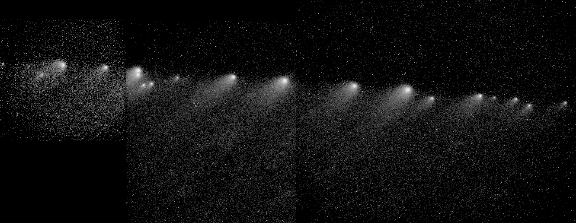Its time once again for another Where In The Universe Challenge. The goal of this challenge is to test your skills and knowledge of the cosmos. Guess where in the Universe this image is from, and give yourself extra points if you can guess which spacecraft is responsible for the image. Post your guess in the comment section (no links to hints please!) and check back tomorrow for the answer. Good luck, dress up for dinner, and have fun.
UPDATE (12/18): The answer has now been posted below. If you haven’t made your guess yet, no peeking before you do!!
Nice job this week, everyone (although I think my favorite answer was a wrong one by “Carl Sagan.”) This is Comet Shoemaker-Levy 9 (named after its co-discoverers), which is often referred to as the “string of pearls” comet. It is famous because it collided with the planet Jupiter: the comet’s original single nucleus was torn to pieces by Jupiter’s strong gravity. The pieces are seen in this composite of Hubble Space Telescope images to be “pearls” strung out along the comet’s orbital path. This image was taken in 1992, and in July of 1994 these pieces collided with Jupiter in a rare and spectacular series of events.
I’ll try to find a harder one next week, but …. I might be lenient since it will be close to the holidays!


Shoemaker-levy by Hubble as the comet got ripped to shreds and smashed into the planet making really awesome black gashes.
Location: Slightly outside the orbit of Jupiter.
Spacecraft: Hubble
This looks like comet shoemaker-levy 9 before hitting Jupiter. It was observed by Hubble as well as Galileo, if I remember right. I’ll say Galileo.
Looks like shoemaker Levy 9 imaged from the hubble to me too.
This is… hm… whatshisname… It ain’t Shoemaker-Levy… or is it? Damn.
OK, I don’t remember the name of the comet. But it’s the one that collided with Jupiter a few years ago in a great pyrotechnic show, after going several times around the planet and fragmenting itself in all those chunks you see there due to its gravity.
The spacecraft who took the photo was, I believe, Hubble.
Definitely Shoemaker-Levy.
My vote is SML9 as well
Ill vote Galileo. too.
It is comet Shoemaker-Levy, in orbit with Jupiter, 4 months before impact. The photo was taken with Hubble Space Telescope in March, 1994.
Shoemaker-Levy 9 in ’94 as imaged by the Hubble, inside the orbit of Jupiter.
It’s Hal Weaver’s “string of pearls” image taken by HST in March 1994. The objects are pieces of comet Shoemaker-Levy 9.
I say shoemaker as well.
Hi Nancy,
I think this group of flitting fireflies are the fragments of the Comet Shoemaker-Levy 9. And the spacecraft captured them is probable the Hubble Space Telescope.
P.S.
Thank you for your great space quiz and fantastic knowledge of the most unrecognizable space places!
Shoemaker-Levy.
oh my gosh I know this one!!
SL-9 about to impact Jupiter. HST.
Shoemaker Levy 9 about to make history
it really looks shoemaker Levy 🙂
It is definitely SML9 but i dont know the spacecraft…
After cheating a bit, it is Hubble ! 🙂
The image was captured among the vast oceans of bullions of stars that we otherwise call space.
the remains of Shoemaker-Levy 9 / Hubble it is
This is the easiest one yet. It’s obviously the fragments of the comet Shoemaker-Levy 9 photographed by the Hubble Space Telescope.
Way to easy
Even I knew it….
That’s my guess, also. The impact of Shoemaker-Levy 9 on Jupiter makes all of our problems here on Earth seem so insignificant.
Comet Holmes
Damn it! Should have looked the other answers before
Shoemaker-Levy 9/Hubble
I guess she wants to make us feel good about ourselves for Christmas.
/Adam
Schoemaker/levy 9, although i an not 100% sure but i believe therse series of pics were taken by the Hubble Space Telescope.
Special effects during a Pink Floyd concert.
Or maybe SL-9.
8 July 1992, increases to 1.6 times the radius (less than 120,000 km). The comet Shoemaker-Levy breaks into a twenty pieces, some of which reach several hundred meters. They extend over 20 minutes of arc, or 5 million km.
As most of readers had pointed to. It is comet Shoemaker Levy 9 in Jupiter encounter and impact. And Hubble Space Telescope pictures from 1994.
Milos Krmelj
From small European country Slovenia
Shoemaker-levi 9, i think…
snow coming down over a football stadium’s lights at night; maybe the JETS.
Some amateur astronomer having a really hard time get his camera set up.
Poor Jupiter, SL-9 is going to your encounter – HST says it will be a hard day’s night
SL-9 would be my guess or some other comet getting close enough to the sun to start shedding debris. I’ll go with Hubble for the image.
Comet Shoemaker-Levy 1993, as it began to separate into pieces.
Shoemaker-Levy 9, Oschin telescope on good ol’ Spaceship Earth.
Taken near Jupiter (Comet Schumaker-Levy 9, during summer of ’94.)
Shoemaker Levy-9, by Hubble I believe.
Shoemaker-Levy on it’s way to Jupiter (for the last time). Hubble, I think.
Shoemaker-Levy, definitely.
That one was too easy.
That one was too easy. You would have to have been unconscious to miss that.
OMG. way to easy.
I remember that whole week. Very exciting, espeacially for us common people that don’t get live coverage of astronomical events.
I remember watching one astronomer (female) view the images with what looked like fear in their eyes.